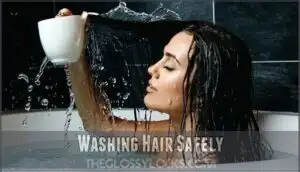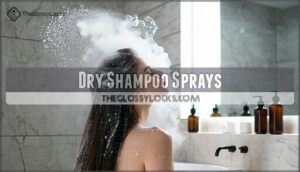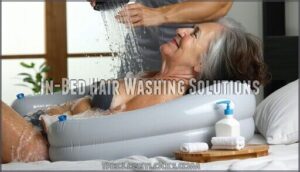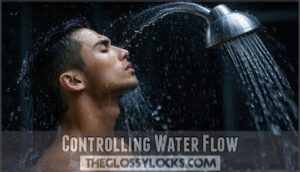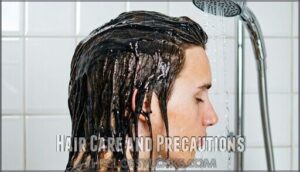This site is supported by our readers. We may earn a commission, at no cost to you, if you purchase through links.
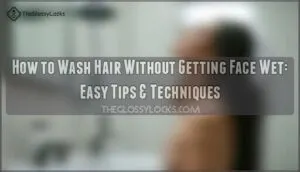 Washing your hair without getting your face wet is totally doable with a few clever tricks.
Washing your hair without getting your face wet is totally doable with a few clever tricks.
Use a handheld showerhead to control the water, or try leaning backward over the sink like you’re at a salon—it’s surprisingly relaxing.
A waterproof face shield or a simple towel draped over your forehead can also keep drips away.
If you’re feeling fancy, grab a friend to help rinse, or stick to dry shampoo for a quick fix.
It’s all about control and a bit of creativity, who says you can’t keep your hair fresh and your face dry at the same time?
Table Of Contents
- Key Takeaways
- Washing Hair Safely
- Wash Hair Without Face Wet
- Alternative Washing Methods
- Controlling Water Flow
- Hair Care and Precautions
- Frequently Asked Questions (FAQs)
- How do I wash my hair without getting water in my eye?
- How do I wash my hair without getting my body wet?
- Can certain hair types require special care?
- How often should hair be washed without wetting the face?
- Are there specific shampoos recommended for this method?
- What are the long-term effects on hair health?
- Can this method help with scalp conditions?
- How to massage the scalp during washing?
- What is the best technique for long hair?
- How to detangle wet hair without damage?
- Conclusion
Key Takeaways
- Use a handheld showerhead to control water flow and aim it away from your face.
- Tilt your head back or lean over a sink to keep water from dripping onto your face.
- Wear waterproof accessories like face shields or goggles for added protection.
- Try dry shampoo as a quick, water-free alternative to cleanse your hair.
Washing Hair Safely
Keeping your face dry while washing your hair doesn’t have to feel like a juggling act.
Keeping your face dry during hair washing feels effortless with the right tools and smart techniques.
With the right tools and techniques, you can clean your locks safely and comfortably without splashing where you don’t want to, and this is a complete solution to the problem.
Protective Accessories and Tools
Shower hats and face shields are lifesavers for avoiding face wetting.
Shower hats and face shields make every wash worry-free, keeping your face dry and your hair care routine stress-free!
Add goggles for eye protection and ear plugs to keep water out.
Dry shampoo is perfect for skipping water altogether while maintaining freshness.
For a variety of options, consider different shower hat styles.
A fitted shower cap guarantees hairline protection without compromising style, helping you to stay dry, stay comfortable, and tackle hair washing like a pro!
Shower and Hair Washing Techniques
Keep water from your face and feel in control with these strategies:
- Use a handheld shower to aim water away from your face.
- Try face-down washing over the tub to redirect water flow.
- Practice upside-down washing for better water runoff prevention.
- Tilt your head back while rinsing with lukewarm water, protecting your hairline and ensuring facial protection.
Hair Washing Challenges and Solutions
Water aversion makes hair washing tricky, but smart solutions exist. Post-surgery precautions, dementia patients, and scalp issues need special care.
Try a tray or inflatable basin for bedridden solutions and aim for gentle hair washing techniques. Use facial protection like goggles or visors to avoid face wetting.
Build comfort with creative methods for a stress-free experience.
dry shampoo sprays
The goal is to make hair washing a stress-free experience with the right techniques and tools, considering the specific needs of each individual, whether it’s post-surgery precautions, dementia patients, or those with scalp issues.
Wash Hair Without Face Wet
Avoiding facial contact while washing your hair doesn’t have to feel like a juggling act.
For those coping with water aversion or facial sensitivity, these tips make the process smoother:
- Upside Down Washing: Flip your hair over a sink or tub and rinse while aiming water away from your face. It’s practical and surprisingly effective!
- Handheld Shower Use: Take control with a handheld showerhead. Direct the stream exactly where you need it, safeguarding your face with ease.
- Shampoo Cap Benefits: Try pre-filled shampoo caps for a no-rinse, mess-free option perfect in a pinch.
- Tilting Head Technique: Master tilting just right—lean back slightly, keeping water flow behind you to avoid face wetting entirely.
For a quick and convenient alternative, consider sink hair washing. Conquer hair washing challenges while keeping your face perfectly protected!
Alternative Washing Methods
You don’t need to soak yourself just to get clean hair.
With a few clever tricks like dry shampoo or in-bed washing setups, you can keep your face dry and still feel fresh.
Dry Shampoo Sprays
Sometimes, life’s too short for full-on hair washing. That’s where dry shampoo saves the day.
Pick a powder or spray that suits your hair texture and scent preferences. Shake, spray, or sprinkle—then massage your scalp. Watch out for residue buildup by brushing thoroughly.
Explore different dry shampoo products for ideal results. Bonus: it’s great for face protection since there’s no water, just fresh, clean vibes!
| Advantage | Tip |
|---|---|
| No wet face | Focus on roots for best results |
| Quick application | Use sparingly to avoid buildup |
| Scent variety | Choose based on preferences |
In-Bed Hair Washing Solutions
Caring for bedridden patients doesn’t have to be tricky.
Inflatable shampoo basins provide comfort and prevent spills, while shampoo caps and no-rinse products are lifesavers for quick, mess-free cleaning.
For a deluxe touch, use a rinse-free sponge bath paired with a hair washing tray.
These handy hair washing alternatives make bedridden haircare easier and keep everyone feeling fresh.
Considering the historical context, people have found creative hygiene solutions throughout time.
Microfiber Washcloths for Low Water Usage
Looking for gentle cleansing without a soggy mess? Microfiber washcloths are your best friend.
With minimal water usage, they’re perfect for medium-length hair and adaptable cleaning. Saturate the cloth and scrub your scalp to avoid water contact.
- Protect your face with these facial wetness hacks.
- Cherish the perks of facial protection methods.
- Stay cool with reduced water.
Controlling Water Flow
You’ve got more control over water flow than you might think—it’s all about simple adjustments.
From lowering the pressure to aiming the stream just right, you can keep your face dry without hassle.
Adjusting Water Temperature
Nailing the right water temperature is key—think lukewarm, not boiling!
Lukewarm benefits include avoiding burns and protecting scalp sensitivity while boosting product effectiveness.
Adjust temperature control carefully to prevent facial wetness. Quick tip: Test the water with your wrist, just like checking a baby’s bottle!
This fosters safe shower techniques and keeps facial protection methods hassle-free. Stay comfortable, not scalded!
Using lukewarm water can also help maximize the benefits of distilled water rinsing.
Using Low Water Pressure
Managing low water pressure can make hair washing gentler and prevent excessive splashing. It’s all about control and balance.
- Use a low-flow showerhead for better pressure regulation and water conservation.
- Keep water flow gentle to minimize splashing reduction and enhance control.
- Position the showerhead close to your scalp for target rinsing.
- Adjust your water pressure for effective yet gentle rinsing techniques.
Aiming Water Stream Away From Face
Tilt your head or lean back to control the water direction, giving your face a break from splashes.
A handheld showerhead works wonders for water contact avoidance, offering precision for facial protection strategies.
Here’s a quick guide:
| Technique | How to Use | Benefit |
|---|---|---|
| Head Tilting | Chin up, tilt slightly | Keeps face dry |
| Handheld Showerhead | Direct flow precisely | Easy water control |
| Backward Leaning | Relax, lean slightly | Enhances comfort |
Hair Care and Precautions
Taking care of your hair while keeping your face dry doesn’t have to be tricky.
With the right products and a little smart prep, you can pamper your scalp and avoid turning hair-washing into a splash zone.
Choosing Right Shampoo and Conditioner
Even the right shampoo and conditioner can feel like treasure hunting. Start by matching hair products to your hair type—curly, straight, or coarse.
Check ingredient lists for scalp concerns like dandruff or dryness. Don’t overlook budget-friendly shampoo brands; many outrank pricey ones in product reviews.
Consider shampoo for each type to maximize hair health. Explore options, experiment, and you’ll find hair care products that work wonders!
- Match products to hair type.
- Analyze ingredients for scalp concerns.
- Compare top-rated and budget-friendly options.
Scalp Health and Hair Growth
Keeping your scalp healthy is key to avoiding hair shedding and supporting growth.
Start with a gentle scalp cleanse only—this removes product buildup without stressing your strands.
Boost your scalp microbiome by using nutrient-rich products and strategies like follicle stimulation.
These hair washing tips minimize facial discomfort, making scalp care a breeze while keeping your hair fuller and happier.
Mobility Limitations and Creative Solutions
Dealing with mobility limits? Sink hair washing is a game-changer.
If you’re in a wheelchair, adaptations like tilting back over a sink or using a shampoo cap for minimal mess can help.
In-bed solutions, like inflatable tubs, make hair washing comfortable.
Limited reach aids and caregiver assistance simplify showering methods.
To avoid dryness, consider preserving natural oils through gentle brushing.
With these tools, sink washing feels effortless and helps in preserving the natural state of hair, making it a comfortable experience.
Frequently Asked Questions (FAQs)
How do I wash my hair without getting water in my eye?
Don’t let water play peek-a-boo with your eyes.
Use a handheld showerhead aimed at an angle, wear goggles for extra protection, and tilt your head back slightly to keep your face completely dry.
How do I wash my hair without getting my body wet?
Try leaning over a sink or tub, using a handheld showerhead for control.
Wrap a towel around your shoulders to stay dry.
Shampoo gently, rinse carefully, and voilà—clean hair, dry body, happy you!
Can certain hair types require special care?
Some hair types demand special care—curly hair craves hydration, straight hair loves volume, and damaged hair needs repair.
It’s like feeding pets; each has unique needs, so pamper your hair accordingly to keep it happy!
How often should hair be washed without wetting the face?
Wash your hair about 2-3 times a week, but adjust to your hair type and lifestyle.
For oily hair, wash more often; for dry hair, less frequent washes work fine—keep the face totally dry!
Are there specific shampoos recommended for this method?
It’s like finding the perfect dance partner—look for gentle, low-lather shampoos like baby shampoos or sulfate-free formulas.
They’re kind to your scalp, easy to rinse, and don’t create sudsy chaos near your face.
What are the long-term effects on hair health?
Skipping full rinses or using unconventional methods can lead to product buildup, scalp imbalance, or dryness.
But don’t fret—choosing good products, scalp cleansers, and washing thoroughly can keep your strands and scalp happy long-term.
Can this method help with scalp conditions?
Yes, it can!
Gentle methods that focus on targeting the scalp without drenching your face but also help to keep you comfortable and help cleanse buildup, improve circulation, and promote healthier conditions for addressing scalp issues effectively.
How to massage the scalp during washing?
Imagine your fingers dancing like raindrops on your scalp.
Use gentle circular motions with your fingertips, not nails.
Start at the hairline, work toward the crown, and enjoy the soothing, spa-like sensation.
What is the best technique for long hair?
For long hair, split it into sections and drape each over your shoulders.
Use a handheld showerhead or pour water with a cup, focusing on the roots.
This keeps your face dry and hassle-free.
How to detangle wet hair without damage?
Detangling wet hair is like solving a puzzle—start slow.
Use a wide-tooth comb or fingers, working from the ends upward.
Apply conditioner or detangling spray, and never yank; patience avoids breakage and frustration!
Conclusion
Imagine effortlessly washing your hair while your face stays as dry as a desert.
With a few smart techniques, like using a handheld showerhead or leaning back over a sink, you can master how to wash hair without getting face wet.
Accessories like waterproof shields or towels add extra protection.
For a quick fix, dry shampoo works wonders.
It’s all about controlling water and being creative—because who says hair care can’t be neat and clever?

